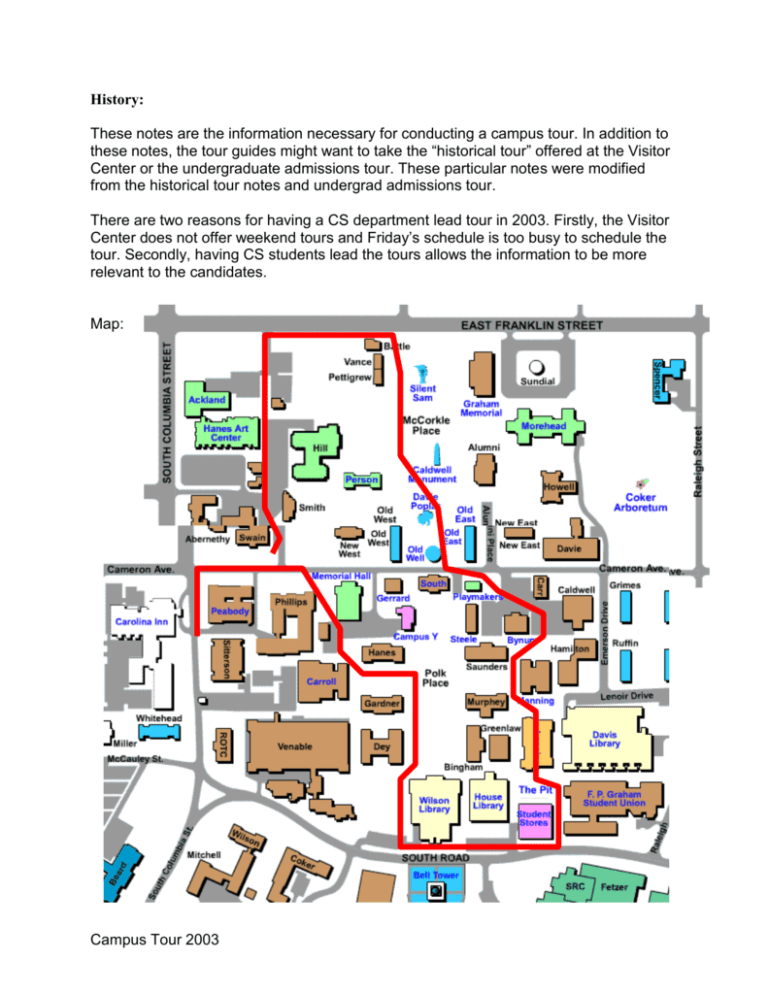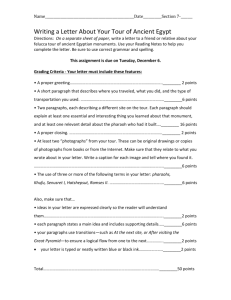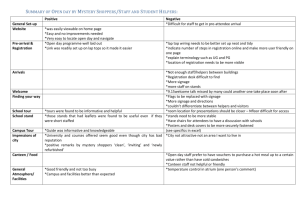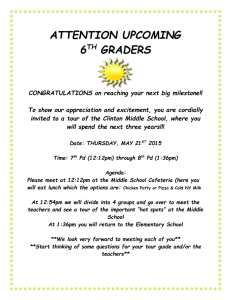Campus tour notes - University of North Carolina at Chapel Hill
advertisement

History: These notes are the information necessary for conducting a campus tour. In addition to these notes, the tour guides might want to take the “historical tour” offered at the Visitor Center or the undergraduate admissions tour. These particular notes were modified from the historical tour notes and undergrad admissions tour. There are two reasons for having a CS department lead tour in 2003. Firstly, the Visitor Center does not offer weekend tours and Friday’s schedule is too busy to schedule the tour. Secondly, having CS students lead the tours allows the information to be more relevant to the candidates. Map: Campus Tour 2003 Introduction My name is ________________, and I will be your tour guide today. Carolina today is ranked among the top research universities in the nation and recognized for having one of the most beautiful campuses. University of Georgia and UNC are the oldest state universities. UNC was the first to open its doors, enrolling students in 1795. This is significant because its so soon after the Revolutionary War that our state displayed a commitment to public education. Chapel Hill originally was called New Hope Chapel, named for an English chapel located where the University-owned Carolina Inn is now. When the site for the University was chosen, the chapel was already in ruins as a result of the Revolutionary War; nevertheless, it provided the name "Chapel Hill." Polk Place Polk Place, the other main quad on campus, is named after James Knox Polk, President of the United States from 1845 to 1849. He graduated here in 1818 having earned the reputation of being dependable, punctual but dull. Classmates teasingly would assert a fact to be "just as certain as that Polk would get up at the first call!" Wilson Library At the end of Polk Place is Wilson Library. It was named in 1956 for Louis Round Wilson, University Librarian for 31 years. It was built in 1929 to replace an overcrowded library in Hill Hall. With its Classical Revival styling unlike any other buildings of the era, Wilson was designed to be one of the grandest buildings on campus. Its reading room on the second floor has a 28-foot ceiling, a magnificent chandelier suspended from a sky-lit dome and massive marble-like Corinthian columns. The Library's impressive design reflects the importance of the special collections it houses. Its Southern Historical Collection, of eight million manuscripts, was the first repository solely dedicated to gathering materials from an entire region of the country. This premier resource in Southern topics includes letters, diaries, plantation account books, unpublished works, oral histories, political, financial, military and personal records documenting 250 years of life in the South. Transport Point out bus stop, and mention free bus service for Chapel Hill/Carrboro area, campus shuttle, maybe parking at night Campus Tour 2003 Morehead-Patterson Bell Tower John Motley Morehead, Class of 1891, first presented a proposal for a bell tower in the early 1920s. His proposal was turned down 3 times by the administration -- first time he proposed to put it on top of the South Building (which is across from the Old Well), second time on the Wilson Library, and third time on the flagpole which was being moved from the McCorkle Place to Polk Place. By this time Morehead had decided to enlarge his project and enlisted the aid of Rufus Lenoir Patterson II. Finally the University and the two families agreed on a site behind Wilson Library for the bell tower. Rising 172 feet, the Morehead-Patterson Bell Tower is surrounded by a hedge and lawn designed by William C. Coker, botany professor and creator of the campus Arboretum. The tower's belfry once contained a carillon of twelve manually operated bells; now there are fourteen mechanized ones. The bells chime every hour (and maybe you will hear them on your tour!) SRC and Gyms (Fetzer, Woollen) Aerobics classes, sports(badminton, squash, racqetball, basketball etc), well-equiped gym, swimming pools Student Stores, the Frank Porter Graham Student Union, Lenoir and the Undergrad Library, the open area between this cluster of buildings called the "Pit". Davis Library Opened on Feb 7, 1984 and cost $22.9 million to build. It has 10 acres of floor space, 500 closed carrels, 1,950 open carrels, and a total seating for 3,013. It ranks among the top research libraries in the US. We have an interlibrary agreement with Duke, NC State, and NC Central Universities that allow students to check books out using their UNC OneCard or to get them within 2 days on Interlibrary loan. The combined holdings on their libraries make the resources available to students second only to Harvard. Wireless Coverage There are many wireless zones located throughout campus (in classrooms, residence halls, and popular student locations) that can be accessed with the use of a wireless card. Wireless cards can be checked out from the library for two hours at a time for free. Campus Tour 2003 Bynum Hall Bynum Hall served as the University's first gym complete with a pool. It now houses the University Cashier and graduate school offices. Playmakers Theater PlayMakers Theater, built in 1852, was named Smith Hall as a tribute to benefactor General Benjamin Smith. It was designed to be used as both a library and a ballroom. This may first strike you as an unusual combination but the logic behind it was simple: the students wanted a ballroom but the administration knew there would be opposition to such a frivolous use of the Universities facilities. So, it was used as a library during the day, and on special evenings the large bookcases were simply rolled back against the walls, the curtains drawn, and the hall was transformed into a ballroom. The building was designed by the distinguished architect Alexander Jackson Davis and built facing east, to welcome the Governor, legislators and the belles coming from Raleigh for the dances. If you look to the top of the columns, you can see a special American touch added to this Greek revival temple. Wheat and corn were substituted for the acanthus leaves that traditionally adorn Corinthian columns. Old Well Today the Old Well is perhaps the most widely recognized visual symbol of the University, although it wasn't always so pleasing to the eye. The original utilitarian, wooden structure was one of the few sources of water for the University community. The Old Well acquired its present form in 1897 when President Edwin Alderman looked out from his office window across the street and decided the ramshackle structure needed refurbishing. He justified the expense by his belief that "Democracy cries out for beauty to give it backbone--spiritual backbone." For $200, a local lumber yard constructed the Old Well that is modeled after the Temple of Love in Versailles, France. McCorkle Place The park-like area between Cameron Avenue and Franklin Street. This is where our University took root. This quadrangle is named for a founding trustee, the Reverend Samuel E. McCorkle. Caldwell Monument The Caldwell Monument is a memorial to Joseph Caldwell, the university's first president. He is buried here with his second wife and her son. Silent Sam Campus Tour 2003 The statue was given to the University in 1913 by the North Carolina Division of the United Daughters of the Confederacy. It memorializes the 321 alumni who died in the Civil War as well as the 1,062 who entered the Confederate army. On the north face of the monument, a heroic woman with sword in hand touches the shoulder of a young gentleman to call him from his academic studies to military service. Historians have noted that the Confederate soldier atop the marker is in full battle uniform but with no ammunition box ... hence his nickname "Silent Sam." Davie Poplar Davie Poplar marks the spot where legend has it the vision of our first state university began to take shape, in the summer of 1793. The tree is actually a Tulip Poplar, more than 200 years old. The poplar is named after the most active of the first trustees, William Richardson Davie, who is called the founder of the University. William Davie is said to have made the comment, "As long as the tree stands, the University will prosper." The tree has been struck by lightning several times. To ensure that it stands, the core was filled with cement and it is supported with cables. As a backup, a cutting of the tree was planted in 1918 -Davie Poplar Jr. As a further precaution, in 1995, Davie Poplar III was planted. A legend about the bench under the tree -- if you kiss your boy/girl friend on the bench, you are destined to marry! Morehead Building and Planetarium The Morehead Building and Planetarium were built in 1949 as a result of an insult. Harvard astronomer Harlow Shapley publicly remarked that "Of all the people in North America, North Carolinians are the most astronomically ignorant." Carolina alumnus John Motley Morehead was infuriated by this gibe and promised him, "If you will amend your statement, Dr. Shapley, to say that of all people in North America, North Carolinians are the most ignorant in astronomical matters, I will build a planetarium to help solve this problem." And Mr. Morehead did just that, making Carolina the first university to own its own planetarium. Coker Arboretum Coker Arboretum is a five-acre garden featuring 400 varieties of ornamental plants and shrubs. At that time the land was boggy and covered with crimson clover and grasses, and most often enjoyed by campus livestock. Following the suggestion of University President Francis P. Venable during a stroll on campus, the botanist William Coker built the arboretum with little money and only one laborer. The arboretum is home to several species rare to the area and is part of the North Carolina Botanical Gardens, located on Laurel Hill Road, which is also open to the public. Campus Tour 2003








